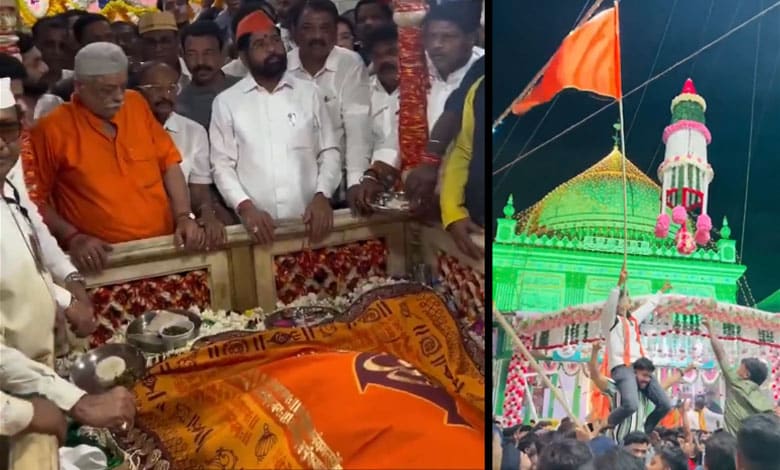Maharashtra Deputy CM Eknath Shinde’s Aarti at Haji Malang Dargah Ignites Religious Controversy
Maharashtra's Deputy Chief Minister Eknath Shinde, along with his security personnel and top officials, visited the Haji Malang Dargah in the Thane region of Mumbai during the Urs celebrations on Saturday, February 15.

Mumbai: In a highly controversial move, Maharashtra’s Deputy Chief Minister Eknath Shinde, along with his security personnel and top officials, visited the Haji Malang Dargah in the Thane region of Mumbai during the Urs celebrations on Saturday, February 15.
Table of Contents
The event sparked widespread debate after Shinde performed an aarti at the sacred Sufi grave site, a move that many found surprising given the Islamic significance of the shrine.
Aarti and Saffron Chadar at the Shrine
During the visit, Shinde placed a saffron chadar, inscribed with OM and names of Hindu deities, on the tomb of the revered Sufi saint. This act was captured on video, which quickly went viral across social media platforms, igniting a heated discussion over religious symbolism and the intersection of different faiths in the region.
Also Read: Rahul Gandhi Meets Telangana CM Revanth Reddy, Discusses Cabinet Expansion and Muslim Representation
Hindutva Group’s Presence at the Shrine
In another video that surfaced online, members of a Hindutva group were seen waving large saffron flags at the shrine. The group, clad in saffron attire, chanted religious slogans such as “Jai Shri Ram” and performed aarti puja while singing bhajans, a form of Hindu devotional music. The scene unfolded within the premises of the Islamic Sufi shrine, fueling further controversy and reactions.
Historical Disputes Over Haji Malang Dargah
The incident has sparked renewed discussions about the Haji Malang Dargah, a site with a history of dispute regarding its origins. The 800-year-old religious site has long been the subject of debate, with some claiming it was originally a Hindu temple before being converted into a Muslim Sufi shrine.
Public Reactions and Concerns
The incident has prompted strong reactions from both religious and political circles, with critics questioning the appropriateness of such actions in a place that is revered by the Muslim community. Proponents, however, argue that the act was one of unity and inclusivity.
In the backdrop of rising tensions around religious sites, the political and social implications of such events are becoming a matter of public concern. The Shinde government has yet to officially comment on the matter, but the viral footage has ignited debates on social media, with people expressing divergent views on interfaith practices and the blending of religious symbols at sacred sites.
As of now, the controversy continues to unfold, with calls from various groups to address the issue and promote interfaith dialogue and understanding.
